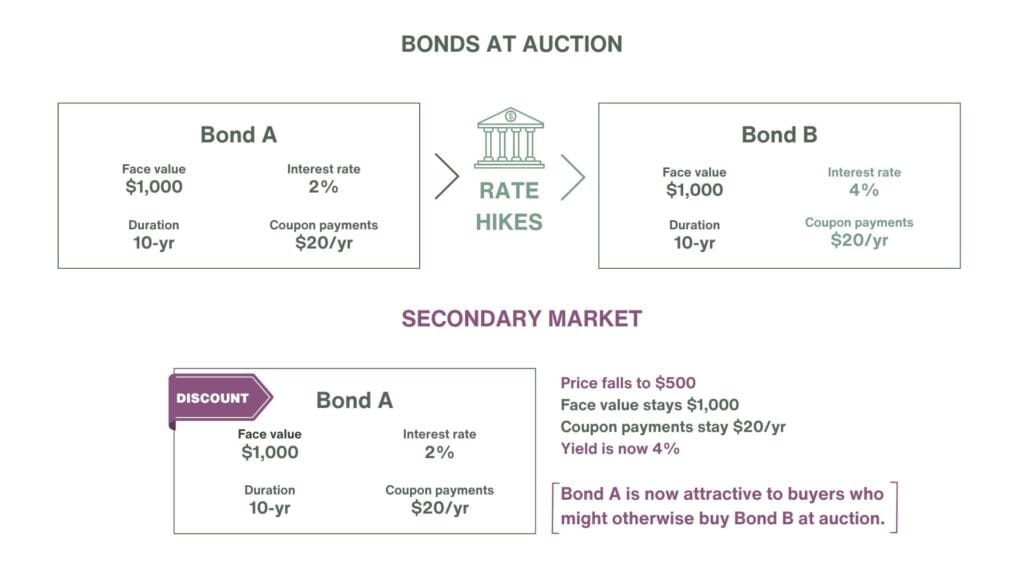In late 2023, mortgage rates hit a 15-year high, topping 7%. Previously, rates hovered below 4%. For any American looking to buy or sell a home, this surge in mortgage rates can feel prohibitive. Given how much equity many Americans have in their homes, any sort of glitch in the housing market can feel worrisome, even if you don’t have any intention to buy or sell anytime soon.
With that in mind, it’s easy to understand why high mortgage rates can cause a certain amount of unease in the market. So we wanted to take a closer look at how mortgage rates are calculated—namely, which indicators you can watch to help you understand what might happen next in the mortgage market. (Hint: It’s not the Fed Funds Rate.)
The interest rate ripple effect
Understanding how the sausage (interest rate) gets made can make even the most financially savvy among us go glassy eyed. We’ll recap it here quickly, but don’t worry about memorizing how any of this works—the goal is to set the stage for the big picture.
When the Federal Reserve “raises rates,” they’re adjusting their target for the Federal Funds Rate—the rate at which banks lend money to each other overnight. But this is just one of several key benchmarks that banks watch. They also watch the Secured Overnight Financing Rate (SOFR) in the U.S. and the London Interbank Overnight Rate (LIBOR).
When finance types talk about how banks set rates on different products, they likely start the conversation with some of this jargon—FFR, SOFR, LIBOR, and more. But the good news is: You don’t have to worry about any of it.
Interest rates ripple outwards, from overnight lending rates to longer-term debt and so on. This ultimately creates a much better, and much simpler, benchmark to use for mortgage rates: 10-year Treasury bonds.
Bonds as a benchmark
Government bonds (known as Treasuries) are widely considered the “safest” investment outside of cash since the U.S. government has never defaulted on its debt. Beyond that, Treasuries pay interest in U.S. dollars, and the dollar is the world’s global reserve currency, creating demand.
As such, the risk and reward of most fixed-income products—loans, mortgage-backed securities, other bonds—tends to be evaluated against Treasuries. The most-commonly used metrics are the 2-year and the 10-year. For longer-term investments, like a 30-year (or even a 15-year) fixed-rate mortgage, the 10-year is the favorite benchmark.
Any time a bank lends you money for a mortgage, they’re taking on risk—even the most creditworthy borrower might default, pay late, sell their home before the end of the 30 years, and so on. The question is: How much does a “perfect” borrower need to pay in interest to make that loan more appealing than 10-year Treasuries? If the alternative is buying 10-year Treasuries, the higher their yield, the more you’ll need to pay to make that investment worth a lender’s time.
Banks also consider the housing market and what other lenders are doing (supply and demand for mortgages). From there, the lender will factor in your personal circumstances, like credit score, down payment amount, and so on to come up with a personal mortgage rate offer for you.
Bond traders and your mortgage
Now that you know your mortgage rates depend on 10-year Treasury yields, a natural next question is: What influences those yields?
That answer requires another quick detour. Many of us think about bonds in classic terms: An organization issues a bond for a certain amount (face value or principal investment), at a certain rate of interest (paid in coupons), to be repaid at future date (maturity). This approach to bond investing requires you to buy bonds at auction and hold them to maturity.
These days, however, it’s more common to buy and sell bonds on the secondary market.
The secondary bond market causes significant fluctuation in both the price and yield of bonds, including 10-year Treasuries. For instance, if those Treasuries were issued with 2% interest and the Fed raises rates, new Treasuries will be issued with a higher interest rate. Let’s say 4% for simplicity. In order to stay competitive, bonds that pay 2% would need to sell at a discount in order to match the yield on new, higher-rated bonds.

In other words: The face value and interest payments of bonds are fixed, but their price and, therefore, their yield vary in the secondary market. And bond traders are influenced by more than just interest rates. As we mentioned earlier, Treasuries are considered “safe,” so if traders are expecting volatility in stocks or there’s a global crisis, traders might buy Treasuries as a safety play. This increased demand could drive up price and cause yield to fall.
Consider this chart, showing 10-year yields in purple, mortgage rates in green, and the Fed Funds Rate in black. Notice mortgage rates jumped in 2021 and 2022 well before the Fed began hiking rates. Those increases largely mirror 10-year yields. Similarly, we see 10-year yields and mortgage rates fall during the summer of 2022 even though the Fed was still hiking the Funds rate.

In other words, if you’re trying to anticipate where mortgage rates are going, ignore the headlines about the Fed, the Funds Rate, SOFR, and LIBOR. Instead, keep an eye on the bond market—specifically, 10-year Treasury yields.
How Revo Financial can help
If you’re interested in buying a home and have questions about how a mortgage might fit into your broader financial plan, we’d love to speak with you. At the end of the day, buying a home is about far more than mortgage rates—it’s about deciding what makes the most sense for your family. Only then do we look at the most cost-effective way to achieve your goals.

